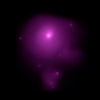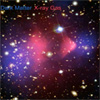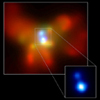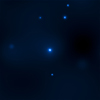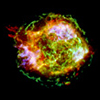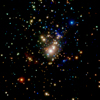Disclaimer: This material is being kept online for historical purposes. Though accurate at the time of publication, it is no longer being updated. The page may contain broken links or outdated information, and parts may not function in current web browsers. Visit chandra.si.edu for current information.
Deep Impact - Chandra Top Ten (Plus One) in Ten
by Wallace TuckerOctober 06, 2009 ::
In its first decade of exploration, Chandra has expanded our view of the universe with its unrivaled abililty to create high-resolution X-ray images of cosmic phenomena: X-ray sources produced by matter circling only a few miles from a black hole, whirling, super-dense neutron stars expelling fingers and rings of extremely high energy particles, a look at the insides of an exploded star, and clouds of hot degree gas in galaxy clusters millions of light years across. None of this could be observed without an X-ray telescope.
In the last Chronicle story, we presented a list of "cool" stories from Chandra's first decade of exploration of the hot universe. Here we give a list of the discoveries from Chandra's first ten years that we think have had a deep impact on the 21st century astrophysics.
DARK ENERGY:
Discovery:Chandra observations of the rate at which galaxy clusters grow by pulling in surrounding galaxies and gas imply that the growth of these immense structures has been stifled by the accelerated expansion of the universe. The prime candidate for the cause of this acceleration is the prevalence throughout space of an invisible energy called dark energy.
Impact:Chandra's independent confirmation of the original discovery based on optical measurements of distant supernovas dramatically strengthens the case for the existence of dark energy. The galaxy cluster work also rules out some alternatives to General Relativity and tightens constraints on the nature of dark energy.
http://chandra.harvard.edu/photo/2008/darkenergy/http://chandra.harvard.edu/press/08_releases/press_121608.html
DARK MATTER:
Discovery:Observations of clusters of galaxies with Chandra and optical telescopes have determined the amount and location of normal matter and dark matter in clusters, which are the largest bound structures in the universe.
Impact:Surveys of galaxy clusters have determined that the universe contains six times as much dark matter as normal matter. Dark matter is revealed through its gravitational pull on normal matter such as electrons and protons, but has so far escaped detection by any type of telescope. In the Bullet Cluster the observed separation of most of the normal matter from dark matter is the most direct evidence yet for the existence of dark matter.
http://chandra.harvard.edu/photo/2006/1e0657/http://chandra.harvard.edu/press/06_releases/press_082106.html
BLACK HOLE CENSUS:
Discovery:Chandra Deep Field observations have led to the discovery of hundreds of X-ray sources that are produced by hot gas spiraling toward supermassive black holes in the centers of distant galaxies.
Impact:The X-ray sources discovered in the Chandra Deep Field observations can explain essentially all the "diffuse" x-ray glow first detected more than 40 years ago. This resolves a long-standing question as to the nature of the so-called X-ray background radiation. The supermassive black hole census also provides insight into when these objects first formed, and how they grow over cosmic time. X-ray and infrared surveys have provided the first direct evidence that most, if not all, massive galaxies in the distant universe spent their youths building monstrous black holes at their cores.
http://chandra.harvard.edu/photo/2001/cdfs/http://chandra.harvard.edu/press/01_releases/press_031301.html
http://chandra.harvard.edu/photo/2007/goods/
http://chandra.harvard.edu/press/07_releases/press_102507.html
BLACK HOLE BLOWBACK:
Discovery:Chandra images have revealed the existence of vast, bubble-shaped cavities and wavelike ripples in the hot gas in galaxy clusters. The cavities extend on either side of the location of supermassive black holes in the centers of massive galaxies, and radio observations show that most of the cavities are filled with high energy particles.
Impact:The X-ray cavities and ripples are dramatic evidence for the repetitive and far-reaching explosive activity associated with rotating supermassive black holes. This activity involves the highly efficient conversion of the gravitational energy of infalling gas into powerful jets of high-energy particles. Black hole blowback plays a key role in the evolution of massive galaxies.
http://chandra.harvard.edu/photo/2003/perseus/http://chandra.harvard.edu/press/03_releases/press_090903.html
http://chandra.harvard.edu/photo/2006/bhcen/
http://chandra.harvard.edu/press/06_releases/press_042406.html
BINARY BLACK HOLES:
Discovery:Chandra's high-resolution image and spectra of a galaxy formed by the collision of two smaller galaxies have revealed two active giant black holes in the central region of the galaxy.
Impact:Over the course of the next few hundred million years, the two supermassive black holes, which are about 3000 light years apart, will drift toward one another and merge to form one larger supermassive black hole. The detection of a binary black hole supports the idea that black holes can grow to enormous masses in the centers of galaxies by merging with other black holes. These events should be detectable with future space-borne gravitational wave observatories.
http://chandra.harvard.edu/photo/2002/0192/http://chandra.harvard.edu/press/02_releases/press_111902.html
SAGITTARIUS A* - BLACK HOLE IN THE CENTER OF MILKY WAY GALAXY
Discovery:Chandra precisely located the X-ray emission from Sagittarius A*, the supermassive black hole at the center of our own galaxy, and measured the intensity and variability of its energy output.
Impact:The rapidity of the variations in the X-ray emission indicates that they are occurring near the event horizon, or point of no return, around the black hole. Even during the flares the intensity of the X-ray emission from the vicinity of the black hole is relatively weak. This suggests that Sagittarius A*, weighing in at 3 million times the mass of the Sun, is a starved black hole, possibly because explosive events in the past have cleared much of the gas from around it.
http://chandra.harvard.edu/photo/2001/0204flare/http://chandra.harvard.edu/press/01_releases/press_090501flare.html
LARGE STELLAR-MASS BLACK HOLES
Discovery:Observations with Chandra, combined with observations of NASA's Swift satellite and optical telescopes have revealed the existence in nearby galaxies of two stellar mass black holes with masses twice as large as the average mass of known stellar-mass black holes. The companion stars for these black holes have very large masses of more than 30 solar masses, and will likely evolve into black holes.
Impact:This discovery shows that stellar black holes can be studied in galaxies millions of light years from Earth and opens up a new avenue for investigating a host of questions involving the evolution of massive stars, the mass distribution of black holes, the formation of binary black holes, and theories of gravity involving extra spatial dimensions.
http://chandra.harvard.edu/photo/2007/m33x7/http://chandra.harvard.edu/press/07_releases/press_101707.html
SUPERNOVAS AND SUPERNOVA REMNANTS
Discovery:High resolution maps of the X-ray intensity and spectra of supernova remnants at different time epochs.
Impact:Chandra observations have resolved the shock waves generated by supernovas and made it possible to measure the velocity of the shocks. These measurements provide the best evidence yet that supernova remnants are the primary source of cosmic rays, extremely energetic particles that permeate the Galaxy and continually bombard Earth's upper atmosphere. The time-lapse images also provide insight into the mechanism for accelerating cosmic rays. X-ray spectra have enabled astronomers to trace the distribution of elements expelled by the explosions, investigate their geometry, and determine whether a particular remnant was produced by the explosion of a massive star or a white dwarf.
http://chandra.harvard.edu/photo/2004/casa/http://chandra.harvard.edu/press/04_releases/press_082304.html
http://chandra.harvard.edu/photo/2007/kepler/
PULSAR RINGS AND JETS
Discovery:Chandra images of the Crab Nebula and dozens of other supernova remnants have revealed spectacular rings and jets surrounding a central neutron star and embedded in glowing, magnetized clouds of energetic particles called pulsar wind nebulas.
Impact:Chandra images of pulsar wind nebulae provide unique cosmic laboratories for studying how a magnetized, rapidly rotating neutron star can generate voltages millions of times greater than those of lightning bolts. These ultra-high voltages create intense winds of high-energy particles flowing away from neutron stars at near the speed of light. The images also illustrate the far-reaching effect of these flows on their environments, and provide insight into similar processes at work around rotating supermassive black holes.
http://chandra.harvard.edu/photo/2002/0052/http://chandra.harvard.edu/press/02_releases/press_091902.html
YOUNG SUN-LIKE STARS
Discovery:Chandra observations of a rich cluster of young stars in the Orion Nebula show that young Sun-like stars with ages between one and 10 million years produce violent X-ray outbursts, or flares, that are much more frequent and energetic than anything seen today from our present-day, 4.6 billion-year-old Sun.
Impact:These studies will help to understand the process for forming planets around young stars. X-rays could ionize the disks of surrounding dust and gas and thereby affect the chemistry, the magnetic field strength and other conditions involved in the formation of planets. The X-ray and ultraviolet radiation from flares, along with associated high-energy particle flows, could reduce the habitable zone for life on planets around the stars.
http://chandra.harvard.edu/photo/2007/orion/BONUS PICK: A NEW KIND OF SUPERNOVA
Discovery:Chandra and optical observations of the supernova SN 2006gy, one of the most luminous supernovas ever recorded, show that SN 2006gy could not have been a normal supernova that occurred in an unusually dense environment.
Impact:One hypothesis to explain the observations of SN 2006gy is that it was a long-predicted but never observed type of supernova that occurs only in extremely massive stars with masses 150 times the Sun's mass. In such stars, the high temperature in the interior leads to the production of pairs of electrons and antielectrons, and triggers a thermonuclear explosion. These types of explosions may have been much more common when the universe was very young, and could have affected the mix of elements present in the intergalactic gas from which the first galaxies formed.
http://chandra.harvard.edu/photo/2007/sn2006gy/http://chandra.harvard.edu/press/07_releases/press_050707.html
-Ten Years of Chandra
-Cool Stories From The Hot Universe
Disclaimer: This material is being kept online for historical purposes. Though accurate at the time of publication, it is no longer being updated. The page may contain broken links or outdated information, and parts may not function in current web browsers. Visit chandra.si.edu for current information.

